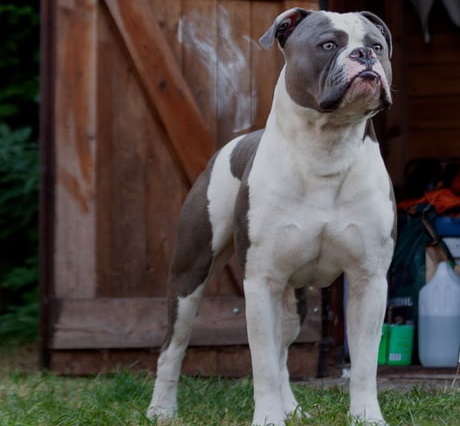Big-boned, sturdy, and muscular yet, agile and athletic – this is how you can describe an Olde English Bulldogge. Although it may look tough and ready to fight, in reality, it is a sweet dog that is always eager to please. Because of its friendly disposition, it gets along with kids and other pets. If you are an experienced pet parent with an active lifestyle, then this is the right breed for you.

David Leavitt, a Pennsylvania-based breeder, crossed English Bulldogs, Bull Mastiffs, American Bulldogs, and American Pit Bull Terriers to create dogs similar to early bull baiters but with a less aggressive personality
Ben Campetti and his wife Karen, from Massachusetts, worked with Leavitt to develop the breed; the Olde English Bulldogge Association (OEBA) was formed
Leavitt halted the breeding process and handed his breeding stock, as well as the Association’s studbook over to Michael Walz, the owner of Working Dog Inc.
Olde English Bulldogge Kennel Club (OEBKC) established
The breed registries of OEBA and OEKBC were merged
The United Kennel Club (UKC) recognized the Olde English Bulldogge
To make sure that your tyke remains strong, healthy, and happy, you should stick with feeding it a nutritionally dense dry kibble. If you want to give your pooch dry commercial dog food, then go for the Hill’s Science Diet Dry Dog Food and Purina Pro Plan with Probiotics.
With light and moderate exercise, you will be able to release your agile and athletic dog’s pent-up energy in a healthy, positive way. Since it enjoys walking, make it a point to take your Olde English Bulldogge on a couple of walks per day. You may also allow it to run around off-leash in a fenced yard.
Your Bulldogge, being a short-coated dog, does not need much maintenance. However, without frequent brushing, your canine friend’s fur may become matted and dirty. Therefore, you need to gently brush its coat every week not just to reduce shedding but also to keep its hair smooth and clean.
Since your Bulldogge is smart, independent, and determined by nature, you must adopt a firm, positive, and confident training-approach. Reward-based methods, using treats and praises for motivation, will surely get the dog excited about training. Make sure to start early with socialization, housebreaking, and obedience training so that it learns responding to basic commands.